|
N9EWO
Review's :
DEGEN DE1123 - DE1125 - DE1126 - DE1127 - Kaito KA1123 - KA801
Pocket MW / FM / SW Receiver - MP3 Player - WAV Recorder's
(DE1126
/ DE1127 review near bottom of this page)
|
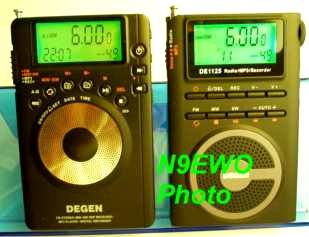
The Degen DE1123 (left)
and DE1125 (right) DSP Radio-MP3 Player-Wav Recorder.
Also sold as the
Kaito KA1123 and KA800 / KA801 in the USA.
We also test the later DE1126 and DE1127 models (review
near bottom of this page).
SW performance is slightly better when you
add a length of thin wire clipped to the whip. (Photo: N9EWO)
N9EWO's Review of the
Degen DE1123
Approx.
Serial Numbers Tested :
First "Defective" DE1123 Sample : EX 0239x
Second "Properly Working" DE1123 Sample : EX 0239X
Third "Properly Working" DE1123 Sample : EX 0294x
Country of Manufacture : (PRC) CHINA.
Discontinued
Model
(Note: The Degen DE1123 is
also sold as the Kaito KA1123 in the USA)
First DE1123 Sample Was A Dud !!
Our first sample
arrived defective from the ebay vendor with intermittent receive
and always on back light. After "priority international
airmail” shipping for the return of the defective sample
back to China, we did receive a properly working replacement.
Defective radio was returned in a padded bag of 5.3 ounces total,
no accessories or box. Replacement speed was as one could hope
for (a 2 week trip). But for a entire month possibility of
waiting and buyer having to pay the cost of returning a defective
sample are disconcerting issues.
The intermittent reception issue appears to be a somewhat
widespread issue with at least early samples. From internet users
reports and from our own disassembly of the test sample to verify
the findings, it appears that a small soldered wire can stick out
slightly from the metal LCD shroud to make contact with the whip
antenna and may cause intermittent receiver dropouts (shorts).
Degen attempted to insulate this area with a small piece of
masking tape (of all kinds of tape to use), and was inadequate in
some cases to create this issue. It is unknown if later
samples/versions
have this possible issue resolved ?
Another Grundig G4 ??
With the “Degen Manufactured” (DE1122) Grundig
G4 biting the dust almost as fast as it came onto the
market, Degen has made the some of the same mistakes again with
the new pocket DE1123 (and DE1125) which also features a built in
off air digital recorder and MP3 player.
Small-Thin Package That Is Actually Pocket Friendly,
General, Included AC Charger is RF Noisy. Very Limited Number of
Buttons
Unlike many so called pocket sets , the new DE1123 is truly a
tiny set. Size is 4 1/4 x 2 3/4 x 1/2 inch (110 x 69 x 13 mm).
Weight is 81 grams without batteries.
Powered by 3 internal and replaceable AAA batteries. 3
rechargeable ni-mh cells are included that have a 650 mah
capacity. Thank goodness these are not of the high capacity type
battery , which have a self discharge rate that drops faster than
a bowling ball rolling down a steep hill. However quality of the
batteries have been a turkey shoot as we have had dud ni-mh cells
with other Degen radios in the past. All batteries insert and
remove with ease.
A number of times during the testing period we needed to use the
rest button found on the sets rear panel after battery
replacement. This does not reset the memories, only the clock and
user setups (12/24 mode, MW steps etc).
Buttons have a good tactile response, and most are dual or triple
function. However, the 4 position mode/band switch is extremely
sloppy-loose (along with a very cheap feel) and who knows how
long it will hold up ?? Volume control is a 32 step electronic
type with up down buttons on the side. The volume can be pre-adjusted
before it’s actually turned on.
External power scheme is similar to the short lived Grundig G4.
That is it uses a USB mini 5 pin connector for power input and
data transfer of audio files, no “standard” round type
power input jack is provided. One can charge the set via the
computer’s USB port or use the included adapter that works
worldwide. Marked as 100 to 250 AC input, however it is not UL
listed.
However one should only use the included adapter for CHARGING and
not for operation as this is one VERY RF dirty "switching"
power supply. It kills MW completely and bothers SW reception
almost as bad. Strong FM signals one may be able to get away with
limited operation with the adapter. The manual even states to use
as a charger only. It’s even is dirty when unplugged from
the DE1123, so be sure and pull it from wall when not being used.
In general it functioned properly for charging use.
The charging circuit is auto sensing type, so no timers are
required to be set for the charge time. Just tap one button with
the set off and that is it. It takes about 7 hours (approximate)
to charge totally depleted cells (with the included 650 mah
capacity batteries). Some early DE1123 samples had a bug with the
charging circuit that Degen has admitted to with along with a
quazi-cure (see photo below).
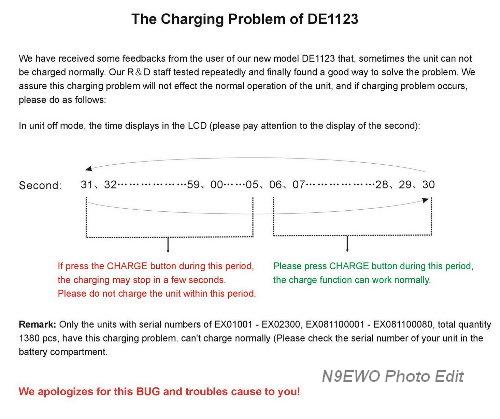
Early
samples of the DE1123 had a bug with internal
battery charging. Degen's cure and "apologizes" in
"Chinglish".
None of our 3 test samples were involved in this
(were all over the effected serial numbers)
(photo
edit : N9EWO)
There is a status 2 color LED on
the charger, but the manual misses what color means what.
Information as given from the ebay vendor after I asked : Green
means that it’s ready, recharging or finished recharging,
Red indicates that it’s in the charging mode. It uses the
North American style vertical 2 blade plug, so no adapter will be
needed with use in the USA. For Europe and other countries one
will need to purchase a plug adapter as it’s not included.
It is not UL listed (is CE).
Important Note: The MP3 player (music) or Rec (voice) modes are
inoperable once the USB cable is attached (either with a computer
or included charger). So one is not able to operate these modes
with the USB cable connected.
Speaking of the owners manual, the English section coves most of
the functions so one can understand basic operation even if parts
are in scrambled Chinglish.
It comes with a 2 1/2 foot USB cable for connection from the
device to the computer or to the charger. This is a bit shorter
than what we would have hoped for.
Attached whip antenna is short (14 inches total), it does not
swivel or rotate. It does not appear to be robust at all either (how
long will it last ??). The internal physical connection to the
base of the whip is soldered glob directly via a a thin wire (no
spade lug or similar used). When headphones or ear-buds are used
the cord becomes the antenna on the FM band. So one can leave the
whip antenna down in this case (but at reduced sensitivity).
There is indeed a internal MW loop-stick for MW reception.
It comes with a light cloth bag (the normal brown color cloth
that Degen uses), but it did not smell of any nasty odors. Not
too great for any real protection however.
Frequency Coverage, 9 or 10 kHz MW setting, Audio Quality.
The DE1123 has good frequency coverage all around. MW is between
522 and 1710 kHz. 9 or 10 kHz spacing is user selectable as well.
LW coverage is not provided.
SW is from 2.30 to 23.00 MHz (no gaps in-between and is all in
one band), FM has extended coverage between 64 and 108 MHz. FM
coverage can also be user selected for between 64 and 108 or 87
to 108 MHz.
Audio quality is adequately loud, depending what band is tuned
and for, so has plenty of punch. As can be expected in a radio of this
size, there
is no bass response to speak of from it’s internal speaker .
No Tuning Knob, Sloooooow Manual Tuning. Other Tuning
Methods, Band Coverage, 225 Total Memories, One Event Timer,
Sleep Timer
The DE1123 has no tuning knob or even a thumb wheel. One tunes
about with the 2 “up-down” buttons that have very
slight muting between stations. There are SW band presets, up-down
scanning, ATS that works well and in all bands too including SW.
As one can tell by looking at the set, there is no direct keypad
entry.
If you need to zip from one side of a SW band to the other (say going
from 11600 to 12100 kHz), it going to be very poky
going as there is no rapid tuning available. Either it pushing
the up down buttons for a s-l-o-w one channel “at a
time” or use manual scan while catching stations along the
way and having to start it back up as it hits.
Tip: In this
situation, one can put it in scan mode with the
antenna down and put it back up once the desired area in the band
is reached. One too has to wonder how well the up-down buttons
will hold up in use with this very slow manual tuning arrangement
? Good news is with a few years of use, those have held up fine.
Thank goodness there are SW band presets for at least the 49, 41,
31, 25, 22, 19 and 16 meter bands.
There are 225 total memories. 100 for SW, 100 for FM and 25 for
MW. ATS starts to save at memory 50 and up on SW and FM and
memory 15 on MW. Memories enter and recall without too much
hassle. When accessing the memory channels, it actually scans
these, so it’s looking for only entries that have real
“active” signals. The ATS and manual up-down scanning
works well and somewhat offsets the lack of a tuning knob or
keypad entry. It’s really a requirement to put these
features to use too especially with the DE1123's limited tuning
methods.
Additionally the memory channels are not battery backed (non-volatile).
However once the batteries are removed it takes less than 5
seconds for the clock and user settings (MW step, clock format
etc) to reset.
There is a one event timer for radio operation, MP3 player or to
record from it’s internal microphone. Unattended (timer) off
air radio recording is not possible, and neither is a alarm off
time (one has to manually shut it off).
Sleep timer was done properly (no auto sleep mode when powered up).
One uses the tuning up-down tuning buttons to select the sleep
time when the radio is off. It can be selected for time between 5
to 90 minutes (in 10 min steps) . Snooze function is not provided.
Real DSP - Works the Best of the Tested Degen Micro Sets - Good
Selectivity, Stability.
The DE1123 has not one “variable” IF transformer,
resistor or capacitor. Everything is mounted on 1 “double
sided” PC board. That is because it uses a real DSP receiver
on a chip and is not done in the audio chain.
However the DSP adds some artifacts and noises (especially
with weaker signals and at lower volume settings). On
the FM band it’s a bit less noticeable, but never the less
is still there. With weaker signals on MW and SW it can contain DSP
noises. If the volume is turned up, the
intensity of the DSP stuff is reduced, but never totally goes
away either.
Again, it’s much less pronounced with stronger signals (but volume
still needs to be turned up) and one may not even notice that
this issue even exists. Does not matter if headphones / earbuds are
used.
Just receiving background static in-between stations can be
abound with the strange DSP noises.
Even with weak signals pop in and out disconcertingly with
the DE1123, after more testing over the years actually pars the best
over the later models tested below. Not that it's perfect (it's not) .
But again If the signal is
strong
enough it does ok, and the audio recovery is above average even
with the weaker (but receivable) stations.
SW sensitivity is fair at best with it's very short whip.
The DE1123's dynamic range is limited and works best only using
it’s attached short whip antenna. It overloads with a 20
foot wire attached and not only is there is the wall to wall
overloading we also heard a local 1 kW local MW station bleeding
all over the place. If one would like to try a small boost to
signals, keep any attached thin wire to 3 to 4 feet maximum (as
discovered in testing). Signals that appear OK with the whip,
TOTALLY disappear with any longer length antennas-wires in use.
There is no external antenna jack and for good reason.
MW does not par as great and being only OK at best using
it’s internal loop stick antenna. But strong regional
stations (in my case Chicago,ILL) came in with good strength, but
MW DX’ers are going to be disappointed for ground wave
daytime use.
FM sensitivity is actually quite good. The
great selectivity helps greatly as well. It separates extremely
tight FM stations with ease.
Selectivity on MW/SW is extremely sharp and here is where the DSP
selectivity helps again. You can separate station like no ones
business here as well. Of course
if the signal you are trying to separate is very weak, it’s
going to pop in and out as well.
Stability is rock solid as it should be.
LCD Has Good Contrast, But Dark Back ground. Excellent
Timed Back light. Selectable 12 or 24 Hour Format Clock With
Seconds When Off
The LCD has very good contrast and most icons are very easy to
read (conditional , see below). The radio frequency display uses
the un-standard Chinese XX.XXx format. But as is the case with
many Chinese portables over the last couple of years the
LCD’s background is at a darker color. So if it’s being
used in subdued light and the backlighting is not in use,
it’s hard to see in this unlit condition.
Thank goodness we have a very nice green LED back light. It only
works in a 15 second timed mode, there is no option to make it
continuous. Does not matter if it’s plugged into the
computer or AC adapter. This is a silly oversight. We did
notice slight interference to very weak signal reception when the
back light was engaged.
When the receiver is off the clock displays seconds and the month
and day. It can be user selected for either 12 or 24 hour format.
With the receiver on, the clock shows up on the bottom left part
of the display (with no seconds).
The digital signal strength meter works well , however it only
displays this for a couple of seconds after tuning and reverts
over to clock with no way to toggle the signal strength
indication on full time.
Off Air Recorder - No Tone Control or EQ Settings
Receiver has a built in MP3 player and digital audio recorder.
Out test unit had 1 GB of memory on board and the outer box
indicated check mark boxes that were at 1, 2 or 4 GB. It’s
unknown if any larger memory versions ever become
available (we don't think so) ? There is no option for any slide
in memory cards to
increase the storage capacity.
The built in “off air” digital recorder uses the same limited recording
quality as the “voice”
recording mode (it actually uses the same “voice” mode
with it’s built in microphone). Format that is only WAV at
32 kbps, 4 bit, sample rate only at 8 kHz. It records in mono
only on FM.
With no MP3 files loaded, the total time for internal
recordings is a shade over 70 hours. The “Voice” and
“Music”(MP3) modes both share the same 1 GB memory. one
engages the recorder the time left within the flash memory is
displayed for about a second made (don’t blink). It then
shows the elapsed time of the recording being as long as
it’s in this mode.
One plus is the radio can be tuned about with the recorder in
operation. With the DE1121, this is not possible. It’s easy
to engage the recorder too, just hold the “Rec” button
for a second and it takes off after a delay of a few seconds.
Much easier over the DE1121 to start record, but again there is
no quality setting either.
NOTE: When recording the pause does not function.
The worse “bug-a-boo” lies with the way the recording
level is accomplished (it’s not automatic). One needs to
turn the volume level up “full bore” to get ANY
level into the recording. In most cases the speaker starts to
buzz excessively and battery life out the window aside with from
ear pain at this loud level. One would be advised to carry along
a pair of low cost earbuds (like the poor sounding ones that come
with it, not important if they get fried after awhile) and use
these when recording off air, but most importantly NOT inserting
into the ears when doing this to save ones hearing. You can hear
enough at a distance away from the buds to be able to monitor the
recording OK.
The voice recorder “Rec” mode (not using the
“radio off air” recorder) uses a built microphone. The
actual microphone is located near the headphone jack but has no
real opening directly exposing it . Has adequate sensitivity for
most personal memo use anyway.
For what the recording quality gives, quality is
very usable (but is not hi-fi..
It generally plays MP3 files OK and clean.
The manual indicated that large MP3 files should be avoided and
as we found in testing this warning should be followed. We tried
a continuous large MP3 file (80 min) anyway and it consistently
locked up and had to be powered down and back up to be
operational again (or had to hit the reset button). We were able
to playback continuous 30 min MP3 files with no problems. However
the closer we got to 60 min is where we started to run into
lockups.
There is no indication in the manual on the maximum file size.
Strangely the DE1121 has never had a problem playing larger files.
So if one has a long recording, it will have to be broken up in
smaller files for the DE1123 to play it
Missing is a shuffle mode, however 2 buttons are provided to
select file folders. But access to folders manually (using the up
down buttons) is very sluggish-slow. (Note: Voice mode has
it’s own “single” folder, that is it cannot have
different folders)
One can select a repeat to stay within the selected folder or
jump to the next one after it’s finished with the current
one. There is no tone control or even any EQ settings with the
radio or MP3 player.
Also MIA is any alpha feedback for the MP3 file information. If
gives you the folder and file NUMBER within that folder for a
SECOND at the start of playing the file (don’t blink again).
Using headphones, we achieved a good 8 + hours of MP3 playback
operation with the included batteries (freshly charged). We felt
that this was more than adequate. As can be expected , operation
using the internal speaker should be less.
Transfer of files between the device and the host computer go
well via it’s 2.0 USB connection (XP home tested), it’s
just drag and drop with no added software required or needed.
Usable and Fun Pocket Set - With Some Bugs
Degen's DE1123 is a fun “Entertainment Center in
a Pocket”. It's spurious DSP noises and downright poky manual tuning
are drawbacks. But in all is most usable provided you take a bit of
time to learn how it operates. The receiver actually works better over
all of the tested models below (but not by leaps and bounds). Uses
common AAA batteries and not some odd lithium ion type which can be a
huge plus (or drawback how you see it).
Dave N9EWO
© N9EWO, all rights reserved
Ver. 4.0
Discontinued
Model
|
N9EWO
Review : Degen DE1125 Kaito KA801
Pocket MW / FM / SW Receiver - MP3 Player - WAV Recorder
|
N9EWO's "Micro"
Review of the Degen DE1125
Approx.
Serial Number Tested : EK 01171X
Country of Manufacture : (PRC) CHINA.
Discontinued
Model
I had a chance to play with one of
the updated Degen DE1125 pocket portable (see
top photo) and to me this later version offers no REAL SW
receiver improvement over the older DE1123 model
above. In fact with the tested sample it was actually worse. The DSP
receiver performance
is even a bit worse. On SW , it cuts in and out even WORSE with solid
signals
than the DE1123. AGC pumps up and down, hissy, sputters,
nasty distortion and narrow audio when it does receive a strong
enough signal. FM performs fine and sensitive (best
part of the set in fact) , but for some reason it takes a much
stronger signal for the stereo to kick in (with headphones in use
of course).
Battery used is now a single Lithium Ion BL-5C type. This battery
has been used in Nokia cell phones over the years. Unknown if
this will be easy to purchase replacements down the road ? The
battery cover is one very thin piece of plastic (better treat it
with kid gloves). I will admit that the operation time has
increased by a large margin and no self-discharge trait to deal
with as with ni-mh cells. But the use of AAA's with the DE1123
model at least made for a low cost and easy switch when all died
out in the field, not so with the DE1125. Clock and date settings
die within seconds after this BL-5C battery is removed, but these
are quick and easy to reset.
The worse part of the DE1125 was when
headphones were used on SW , (yes I
tried different phones and earbuds). The audio went into nasty
"oscillation-motor boating" to make it totally
unusable . The speaker output never was a problem with this
issue.
Have a listen here : A "mp3" audio
file as recorded off the receiver, SW on 10 Mhz WWV. first
without headphones then with.
FM and MP3 "headphone audio" is a bit more muffled when
compared to the DE1123. Also the headphone jack is on the BOTTOM
of the unit. The DE1125's speaker output also has excessive bass
response that adds much more break-up audio distortion on the SW
and MW bands even at low levels.
The tilt stand is a nice touch and latches properly to the set (but
is very thin tab of plastic). Still the radio and mp3
player lack any tone or EQ controls.
A nice tuning knob improves tuning over the DE1123. However it's
very touchy, skips a channel or too while rotating, has a
muting-chuffing
trait on all bands and slight rotational play. But it's not
wobbly (at least when new). Unlike the DE1123, the cabinet with the
DE1125 has the dreaded paint to give that "rubber" feeling that so many
Chinese radio have these days (and will get sticky in time). The MP3
player capacity is now at
2 GB which is double over the 1123, but alas we still are lacking
a shuffle function. The user can now select a mp3 file using the
tuning knob which is a huge plus.
Good news is the DE1125 can record "off air"
without having to turn up the volume full blast as with the DE1123.
As long as it's electronic volume control is set at 1 or above,
the record level stays the same. However, with the tested sample
when we plugged in earbuds or headphones on MW or SW, the nasty
oscillation went on the recording too !! Another downer is that
the recorded file is using the same lousy "32 kbps
8 kHz" WAV format (just like with the DE1123 / KA1123) ?
Also it's still lacking is any automation for timer RADIO
RECORDING.
I love the idea of having a good performing pocket radio with a
"off air" built in flash recorder. But if your want
decent SW reception, I have to say you are much better off to go with the Degen DE1121 (or
Kaito KA1121...that is if you can find a nice used one).
Will admit that this could have just been a sour sample I used,
but maybe not for all bugs as listed above (including lesser
audio quality) ? The later DE1126 model is a step up in record
performance (review below).
Kaito in the USA is (was?) selling a variant of this Degen model
known as the KA800 (no SW but weather instead)
and a identical version to the DE1125 as the Kaito KA801 (with
SW) . We say totally forget the DE1125 !
Dave N9EWO
© N9EWO, all rights reserved
Ver. 5.0
Discontinued
Model
|
N9EWO
Review : Degen DE1126 / DE1127
Pocket MW / FM / SW Receiver - MP3 Player - WAV Recorder
|
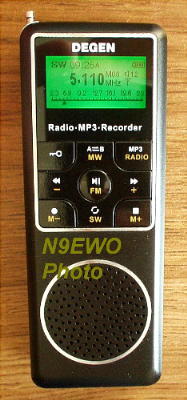
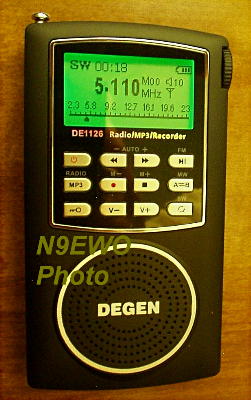
The 3rd generation
"pocket size" Degen DE1126 (right) and even smaller DE1127
variant (left) "MW / SW / FM / MP3 player / Digital Recorder"
.
SW reception is actually worse when compared the DE1123, but only with
added wire to the whip. But neither are DX radios either on MW or
SW.
On board record
function is a mixed bag even if it has a better WAV 129 kbps
recording rate, The other 40 kbps MP3 setting is totally
worthless.
A "crackle tick-tock"
sound appears on some off air radio station recordings (varies,
see text).
Mp3 Playback is
improved including EQ and "shuffle" functions . Display
supports artist and title too if provided.
The DE1126 has the edge to our ears as the longer whip gave for
better FM performance. (see text).
One other variant of
this model , the DE1125-4G was not tested .
UPDATE
: WARNING ! I can no longer recommend the DE1126 or DE1127 for
purchase (see text).
(Photo : N9EWO)
N9EWO's "Micro"
Review on the Degen DE1126 / DE1127
Approx.
Serial Number Tested (DE1126): GC 0362xx
Approx. Serial Numbers Tested (DE1127): Sample 1 : GH 0109xx
Sample 2 : (missing, was a "Demo" sample from Tecsun
direct)
Firmware Version Tested (DE1126) : v0.2.6 ENG (Custom
Firmware for Kaito USA Imports)
Firmware Versions Tested (DE1127) : Sample 1 : v0.1.7 Sample 2 :
v0.1.8
Country of Manufacture : (PRC) CHINA.
(One DE1126
and Two DE1127's were tested for this report.)
Discontinued Model
DE1127 "Super Tiny and Fragile" / AC Charger AWOL ?
The DE1127 is the smallest Degen version of this series to date.
Size is approx 4.25 x 1.6 x .7 inches. There are
larger versions of this model sold as the DE1126 (also tested)
and DE1125-4G (not tested). All use the same firmware and
operating scheme (different button layout). The DE1127 is in a
smaller package and lower speaker audio amplifier (which sound
pretty good considering the size of the speaker). Headphone jack
is located on the top. The DE1126 is a bit larger at 4.5 x 2.5 x .6
inches. Also (duh) the 1126 has a larger speaker for improved
audio quality.
No rubber painted cabinet used with the DE1127. Metal (cover only)
on the front panel with flashy chrome accents. The slide on rear
cover is plastic and on the very thin fragile side. The short
approx 10 inch 4-section whip antenna is also VERY THIN and
fragile and in my view can (will) get damaged very easily if not
extremely careful. The DE1126 does indeed use a "rubber
painted" cabinet and WILL get sticky in time. Whip is a more sturdy and
a little bit
longer too on the 1126 (6 inches longer). Might not seen like
much , but we found this to greatly improve the FM performance.
Buttons on both have a have great tactile feel even if a few of
the front panel buttons on the DE1127 get slightly wobbly after
some use. Side mounted “thumb wheel” (or knob with the
DE1126) tuning and menu encoder has a good feel too (no slop) but
if turned too quickly UP it will skip. There is a RESET button
located inside the battery compartment as with the DE1123 (but
not the DE1125).
Neither version normally does NOT include any external AC wall
battery CHARGER. In this case any 5 volt USB after
market power adapter should work rated 500 ma or more . This
is the first model in this Degen series that can REALLY use an after
market 5-volt USB charger. The resellers where our test
samples came from , included a universal 5-volt USB wall charger
in the deal, but is NOT normally included by Degen (and so
indicated on the "box rear" feature list, last line).
One can operate the set while charging the battery. However DO
NOT press the power button after the USB power supply is plugged
in. Just hit the menu button. SW or MW reception will of course
suffer here, as most USB power supplies are of a switching type.
There are no USB drivers to have to deal with.
Menu’s / No More Mechanical Switch / Now Proper
Frequency Display Format / Improved MP3
Lots of menu’s with the DE1126 / 1127 but are easy to use
and follow. However, if you are a menu hater, you will not be a
fan of these little radios. But it's not hard to deal with.
LCD has icon’s for most functions and has a nice timed lime
green back light. The mechanical mode switch found on the DE1123
and DE1125 models , has been totally removed and everything is
now switched via the menu's electronically. The radio menu
selection is mis-marked as "FM Radio" (for all bands).
Expect with the V0.2.6 ENG firmware where here it is properly
labeled as just "Radio".
Contrast and the length of the backlight (up to 30 seconds) are
adjustable. Yes, the LCD is small and for over 50 eyes is going
to be ruff to see more so with the DE1127 (DE1126 or DE1125-4G
larger version are better here of course). Also just as it is
with the GRE PSR-800 scanner the LCD is near impossible to see
without the backlight in use. This is a dot matrix type display.
However with the DE1126, you can get the contrast a bit darker (along
with the much larger screen) and helps on this front.
Also improved is the frequency display format from the 1123 and
1125 models. No more XX.XXx (now the proper XX.XXX Mhz readout)
MP3 player now has “shuffle” (even if it does not work
the greatest), EQ adjustments and even artist and title
information if provided. Our test samples both had 4 GB of memory.
You can even adjust the tempo if you want to zip over a recording
(music or voice) a bit faster. We found the EQ settings to sound
richer with the DE1126 for some reason (more so with GOOD
headphones of course).
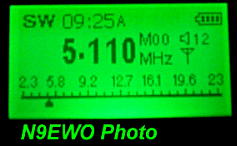
The LCD shows it's
entire SW coverage (2.3 to 23 Mhz) when FIRST selected (see the
lower scale in photo above).
One can tune or scan the entire coverage of the set in this mode
, but as soon as the SW Button is pushed again
to access the band presets it can only scan and tune that band
shown on the scale on the bottom of the LCD.
Sorry , there is no way to tune in between the 5 kHz steps. (Photo :
N9EWO)
General
Reception Performance / Defaults to Chinese on DE1127 Sample
On SW using it's whip alone it's super DEAF, like it's not even
working. When a thin wire is clipped to the whip (say 5 meters /
15 feet or more in length). It comes up to life with usable
levels (but not by much). The best part is signals do not chop in and
out as bad as
the DE1125 (Kaito KA801), so you can hear more stations. Not that
it's a DX machine (no way), but now at least usable with an
added wire antenna, which was not possible with the DE1125. In
fact we connected to an outdoor long wire with good results, the
only real bug was with a local MW overloading on SW with any
external antenna connected. SW signals that suffer from even mid
to severe fading will still have the AGC issues as with the DE1125
and is hard to put up with .
FM band sensitivity : In the case of the DE1127 , it is better on
the DE1125 (KA801). The shorter whip on the 1127 could be the
issue here? The 6 inch longer whip with the DE1126 cousin
improves the FM by a good margin, now equal to the DE1125. MW is
a bit better on the DE1126 too, but is no DX machine either. Both
1126 / 1127 have a buzz on MW that lurks in the background when
no signal is present on weak stations (also to an extent on SW as
well) .
By the way as it does with most of these types of radios, the
headphone cord acts as a “defacto”
antenna on FM. Sadly
it lacks any external antenna jack and would have been a huge
plus as we covered above.
Selectivity on SW is slightly wider so overall audio has been
improved here. MW audio is about the same as compared to the DE1125.
A major annoyance happened "Sometimes" when we took the
battery out with the DE1127 test samples (but not always, change
it out within 30 seconds to lower the risk) the menu defaulted to
Chinese. So if the language menu resets, you have to hunt around
for the language toggle (a royal pain in the $%&!). This is a
variable and one is not advised to change batteries too often (unless
you understand Chinese). We never have seen the DE1126 test sample ever
default back to
Chinese (IMPORTANT NOTE : This is with the Kaito V0.2.6
ENG firmware ONLY) .
Internal Recording Quality / Set The Volume Control At
"10" BEFORE Any Recording / Very Annoying "Tick
Tock" Recording Bug
The DE1126 and DE1127 both offer on board “off air”
recording as well as from the built in microphone.
For the “off air” recording there are two quality
selections. One is in the WAV format at 129 kbps (sample rate
16000 hz) and the other is MP3 at 40 kbps. The 40 kbps MP3
setting is so narrow hollow sounding that is pretty much useless.
The other 129 kbps WAV format makes for improved recordings. IMPORTANT : Adjust
the volume setting to " 10 " BEFORE YOU START RECORDING (be sure it's set at 10
no more...no less). Volume level effects the recording quality in
MY testing. If it's set any higher, more distortion will
be heard. I say more distortion as the MW/SW receiver sections
have it's own distortion and buzzy AGC traits (varies with any
given station) and it seems have a bit in there no matter what
for most signals (but not always either).
Even a more nasty issue is (on all bands) , there can be a very
annoying crackly "Tick-Tock" clocking sound (mixed in
with the station) when the “off air” recording mode is
engaged (with both DE1126 or DE1127 models). The amount of this
self-generated microprocessor noise varies a bit with frequency
tuned and signal strength. Sometimes it will be killer, other
times it will not. With super strong signals you will not detect
it.
Another important point is in any “off air” record mode
the level coming out of the speaker changes to a LOUDER fixed
level and cannot be changed [volume control needs to be set at 10
for "off air" recording for reasons above]. At least
with the DE1125, you have control of the volume in the “off
air” record, and as long as you keep it at the first setting
or above. Again with the older DE1125, the record level is not
affected by the volume control setting (as long as it is at least
set at 1). You may wish to keep a pair of earbuds/headphones
handy (but maybe not put them in/on).
When making voice recording off the internal microphone, there
are a number of DIFFERENT settings. Here the format is WAV and at
256 kpbs. Also there is a VOR mode (voice activation). It makes
very decent sensitive voice recordings. Pause works in record as
well, but has a 3 minute limit before it shuts off (saves the
file of course).
But why the variances between “off air” recording and
“internal mic” recording modes and also at totally
different bit rates is a very strange question.
Same BC-5L Battery (Capacity Varies) / Good Battery Life
/ My Own English Manual/ High "1 ma" idle current (Easily Fixed)
The DE1126 and DE1127 both use the same "cell phone"
BC-5L lithium ion battery as with the DE1125 . Capacity rating
with the included battery test sample was 1020 mah with the DE1127
and 850 mah with the DE1126. It took 4 hours to charge the 1020
mah battery from a dead state (battery low auto shut off).
Battery life (operation time) is good .After 3 cycles of the 1020
mah battery for full capacity, we had (approx.) 10 hours
operation time on a fresh charge (NOTE : MP3 playback mode,
speaker operation and at 12 volume level, no backlight use,
"Soft" EQ setting, shuffle mode with no knob or button
use in the time frame). With louder volume, different EQ , and/or
any backlight use etc...this will be reduced (duh) . Radio use
should be about the same time frame, however when tuning around
the backlight will be on of course and reducing battery life.
IMPORTANT NOTE : The lithium-ion battery will become totally
discharged when in the OFF state (with "Power Off Mode"
left at default, see "Blue" block below for a way
around this). Yes, if you leave the set idle without charging it
(starting fully charged) , in a few weeks (say in 4 weeks or less)
the battery will become totally dead. Clock and idle
microprocessor current is a bit excessive at 1 ma (1mah , so for
the reason why). You should get in the habit of fully recharging
it just before taking it out of the day, recharge it maybe every
2 weeks if you use it or not, or just remove it. If left in a
dead state for any length of time , will greatly reduce the life
of the pack (see below) .
Increased “Off” Battery Life with Grundig G2
Reporter / Degen DE1126 - DE1127 - DE1128 - DE1128H - Important Tip :
As out of the box, when “OFF” the Grundig G2 Reporter / Degen DE1126 /
DE1127 / DE1128 / DE1128H portables have increased standby current
consumption for the clock display (when the tuning knob is rotated). So
even when not being used the internal lithium battery charge will be
completely depleted in a few weeks without even any use (this is
normal). To greatly improve battery life when “OFF” , access the
“System Set” menu (System Setting) then select the “Power Off Mode”.
Toggle the default “Standby” setting over to “Sleep” mode (called
“Hibernate” with some Degen sets). This will greatly increase battery
life when “OFF”. Note: The clock will no longer be accessible with the
“Sleep-Hibernate” selection. Also,
if you remove the battery (or it goes totally dead) this setting will
have to be redone, as it defaults to "Standby Mode".
|
So You Are
Hearing Some Dropouts On MP3 Files With Your DE1127 ??
Also once in awhile we were experiencing MP3 player
dropouts with the SECOND DE1127 test sample (later firmware V0.1.8).
We found this had to with the EQ "NORMAL" setting .
Just selecting any other EQ mode and was issue was cured . So
perhaps a firmware related bug ?? We NEVER experienced MP3
dropouts with the "Kaito" DE1126 test sample in the
NORMAL setting .
Improvement Overall But a Bit Backwards with the Internal
Recorder / DE1126 is the overall clear winner to my ears .
The DE1126 and DE1127 with at least improved SW reception over the
DE1125 (but
only with help on the antenna, the DE1123 is still the best of the lot
but only slightly) and MP3 playback improvements is a
neat SMALL “low cost” device. FM and MW par a bit
better on the DE1126 (longer antenna's ?).
Sadly the “off air” recorder part with the strange
noises made for some disappointment (more so with the tiny DE1127).
The DE1126 has improved record performance over the DE1125 with
the higher bit rate (firmware V0.2.6 ENG). Please keep in mind we
have NOT tested the DE1125-4G variant of this product. Overall we
find the DE1126 to win the horse race with all models shown here (with
it's better MP3). But as pointed out
above it is no DX machine either.
We have covered before , Degen products have a very nasty
tradition of having an above average "dud rate" and /
or variable performance . So the usual caveat "warning"
must be stressed here once again.
WARNING
: Here at HQ we have now received many reports with DE1126
samples (most were with Degen V01.8 firmware with Random play in
use) that are having nasty MP3 dropout issues, yes just like the
Grundig G2 Reporter. You MIGHT still have luck as I did with a DE1126
sample from KAITO Electronics in the USA (or not) . So I can no
longer recommend the purchase of the Degen DE1126 or DE1127. At
your risk as they say !!
Dave N9EWO
© N9EWO, all rights reserved
Ver. 9.0
Discontinued
Model
|
Quality
of Internal Construction with the DE1127 is FAIR .
|
We had a peek
inside the first trashed DE1127 sample (just before
it REALLY HIT the trash can) and I must say construction to me was fair
at best !! The whip antenna in the DE1127 is just
poorly tacked soldered in place on the PC board (no screws at all) and
just barely too with poor lead free solder. The super thin antenna fell
apart as the case was taken apart. The rest of it is not much better
either I'm afraid. Sorry to say this was a real sad showing for a 21st
century electronic device even at this low price point . (DE1126
version is unknown with it's longer whip, but I can say that it at
least uses a screw to hold it into place).
Dave N9EWO
© N9EWO, all rights reserved
Ver. 3.1 |
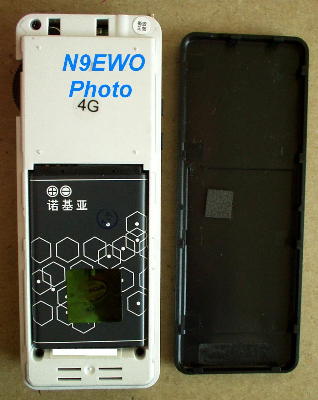
The
Degen DE1127 with
the VERY fragile "slide off" rear cover removed (4 GB
of memory).
Uses the same lithium ion BC-5L battery as with the older DE1125
, Kaito KA800 and KA801 models .
A RESET button is located under the battery (DE1126 or DE1127)
. MP3 player features a "Shuffle" mode,
but does not work
very well (repeats selections way too soon). (Photo :
N9EWO)
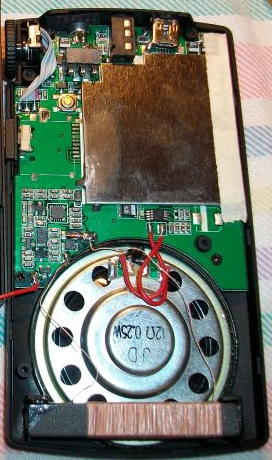
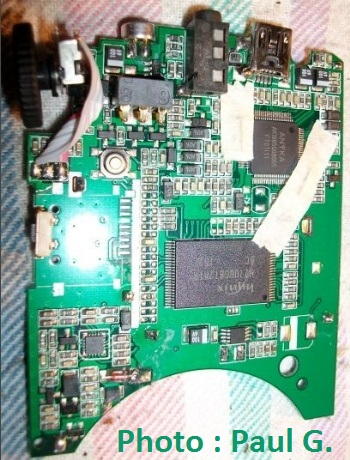
Internal Photo
of the Degen DE1126. The use of "masking tape" and a soldered "tacked
on" connection
to the base of the whip antenna continues as with the first DE1123
model. A nice metal shielded at least.
The entire receiver section is located on the lower left part of the PC
Board . Nothing to get excited about internally.
Photo on right shows the main PC board with metal shielded cover
removed. (Photos
Courtesy of Paul G.)
|
I
will NOT be held responsible for any info that is listed here
ALL
DONE AT YOUR OWN RISK !
|
To Main Page







